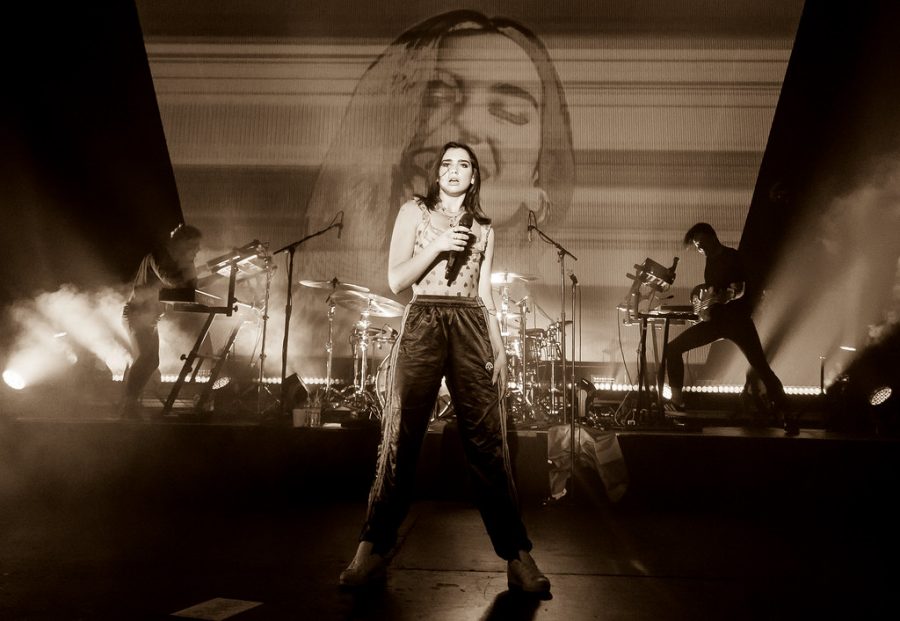Column: Dua Lipa’s Future Nostalgia gives us the fuel we need to get through the pandemic
“Dua Lipa 02/12/2018 #41” by jus10h is licensed with CC BY 2.0. To view a copy of this license, visit https://creativecommons.org/licenses/by/2.0/
March 29, 2021
When Dua Lipa released her sophomore album Future Nostalgia a year ago March 27, the world’s attention was focused elsewhere. The COVID-19 pandemic was in full swing, stretching hospitals to full capacity, emptying city streets and shutting down businesses. The global mood was somber, and Lipa herself was understandably worried that a disco, retro-pop album was going to be the last thing on anyone’s mind during a time of such sorrow.
Future Nostalgia could not have come out at a worse time. Lipa may have imagined her 11 new songs blasting through Ibiza and Miami during the summer, but the vast majority of the world’s clubs remained closed throughout the year, their dance floors collecting dust.
The purpose of Future Nostalgia at its core is to provide listeners with a visceral, unapologetically pop music experience. Drawing upon ’80s influences like Olivia Newton-John and Madonna, Lipa created songs that would make people dance in a manner befitting the disco era from which she drew so much inspiration. From “Don’t Start Now,” a forget-your-ex feminist anthem, to “Physical,” a dance-till-you-drop banger, the album was made to live, breathe and die on the dance floor.
Yet Future Nostalgia underwent a metamorphosis in quarantine. Instead of pulsating through parties and clubs, the album’s songs played through phone speakers while we were on TikTok at 4 p.m. in our pajamas. This unforeseen change of situation elevated Future Nostalgia to something more than just a playlist of fun club songs — it cemented the album as a masterpiece of music that both defined and got us through quarantine.
The pandemic changed “normal” forever. Everything we took for granted, such as maskless faces and bodies rubbing against each other in a hot crowded room, is out of reach for the foreseeable future. The only thing we can do right now is reminisce about fun times in the past. In a way, Future Nostalgia perfectly answers that call by paying homage to the legendary ’80s, a period characterized by fervent dancing and relaxed inhibitions. The album represents the things the pandemic has taken away from us: the activities that let us temporarily forget about our worries and the pleasurable feelings that give so much color to our lives. Listening to Future Nostalgia is the best way anyone can fill those voids right now, which might just be why we keep listening to it an entire year after its release.
Indeed, scientific evidence can explain this phenomenon. Studies published in the past decade have shown that nostalgia decreases feelings of loneliness and can serve as a reservoir of mental wellbeing and emotional stability. When people become nostalgic, they are revisiting positive memories that are personally meaningful to them. In doing so, they become inspired to do things that will let them reach the same level of joy they felt in the past. In other words, nostalgia causes people to become happier and more motivated to pursue future goals.
Even though most of us weren’t born in the 1980s, we are well aware of the decade’s aesthetic and vibe. The constant reference to, and romanticization of, the disco era in contemporary pop culture — through movies, TV shows, songs or otherwise — makes us all feel like we have a personal connection with ’80s glitter and glamour. In a way, we do: What college-aged person hasn’t had their parents blast ABBA or upbeat Whitney Houston songs throughout the house when they were young? As such, Future Nostalgia provides us with a blast-to-the-past nostalgic experience that brings us back to happier non-pandemic times, with tangible emotional benefits both for the present and the future.
The sheer energy of Future Nostalgia also achieved this same goal by supplying us with the fuel we needed to get through quarantine. I don’t need to reference any scientific studies to correctly say that high-tempo songs get our bodies moving. The album’s synth-heavy, groovy-bass songs provided everyone with the perfect soundtrack for dancing in the living room with reckless abandon or in their room at 2 a.m. if they’re a little shy.
These songs, through their serotonin-inducing instrumentals, allowed us to retain a semblance of optimism for the future — optimism that we can soon be back to dancing blurry-visioned and shoulder-to-shoulder with five other strangers. I can’t be the only one to have closed my eyes and pretended I was at a party when dancing to “Don’t Start Now” alone or with a couple friends at home. It’s easy to get pandemic fatigue and resign yourself to the opinion that the current state of things will never change. Future Nostalgia comes up, slaps you across the face and tells you to shut up while screaming, “You WILL eventually get the opportunity to embarrass yourself at a function again.”
True to its name, Future Nostalgia draws upon the past and future in an attempt to excite and electrify listeners. This goal is successfully achieved with its unskippable 11-song tracklist, but the album gains so much more meaning considering the state of the world into which it was released. So, even though we’re currently only able to dance to Future Nostalgia in a t-shirt and some sweatpants, don’t be too sad when glancing at the party outfits in your closet. Keep listening to the album and stay nostalgic for a future that is soon to come.







